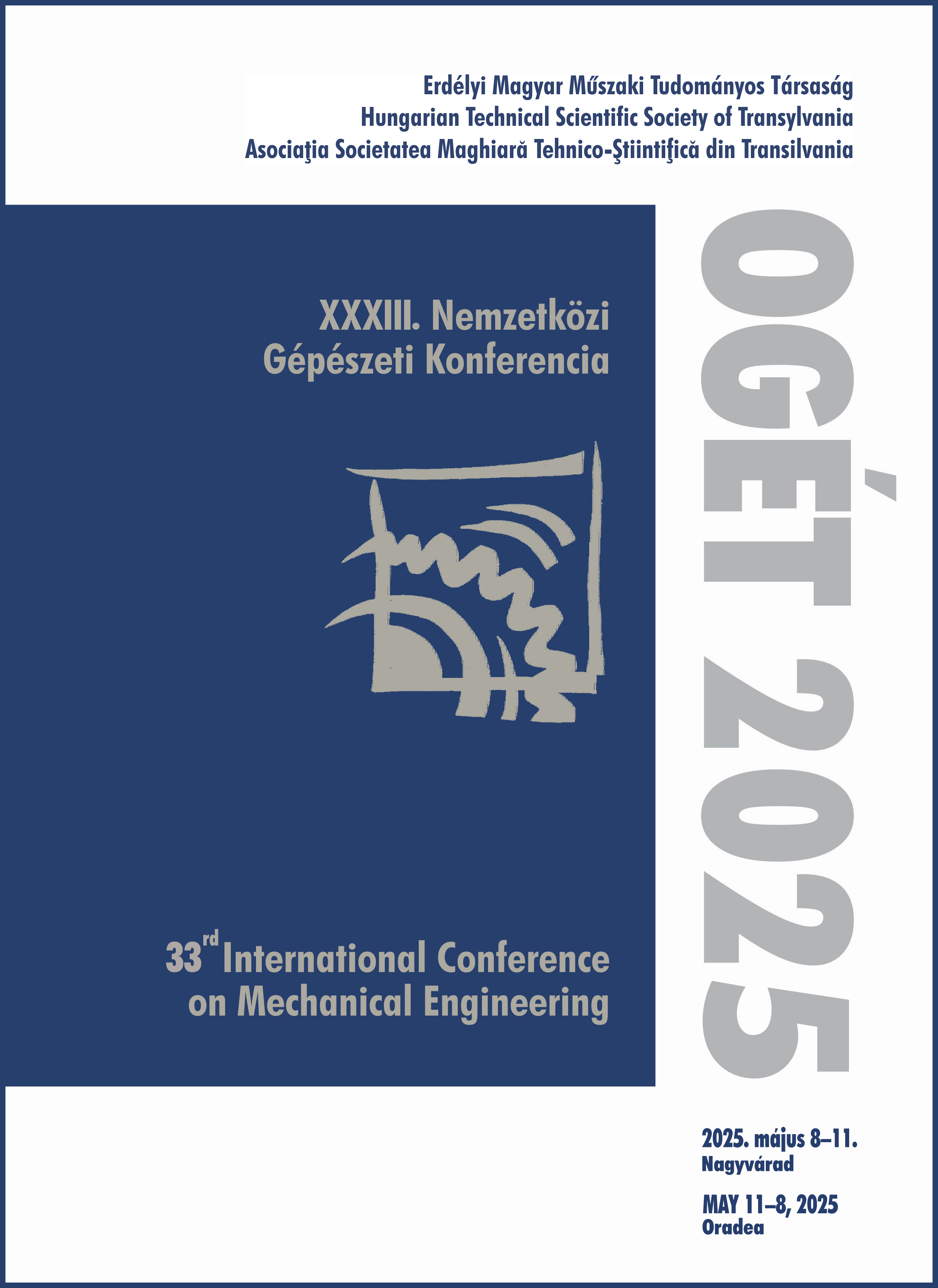A térdprotézis kopását leíró analitikus modellek: Lehetőségek és korlátok
Analytical models to describe wear in total knee arthroplasties: Possibilities and limitations
Keywords:
analytical models, wear, cross-shear ratio, slide-roll ratio, coefficient of friction, /, analitikus modellek, kopás, keresztirányú, nyírási tényező, súrlódási tényező, csúszva-gördülési tényezőAbstract
Different types of wear mechanisms (three-body wear, delamination, pitting, abrasive, etc.) can occur between the polymer-metal interface of total knee arthroplasties. In most cases, the mechanism of these types of wear has only been experimentally verified or approximately described. Analytical description for the majority of wear types is not yet available. One exception of these mechanisms is abrasive wear, for which a number of analytical studies have been developed. This wear type can be mathematically approximated by the so-called Archard equation. It must be noted that the original Archard equation must be extended by several parameters, due to the complex motion of the knee joint, to adequately describe the wear process. Such parameters are the cross-shear ratio, the coefficient of friction or the sliding-rolling ratio. The present study gives a broad overview about the currently available analytical wear models from the relevant literature and it also provides further suggestions how to bring these models closer to reality.
Kivonat
A térdízülethez kapcsolódó protézisek műanyag-fém kapcsolata között különböző típusú (háromtest, réteges, kipattogzó, abrazív, etc.) kopás léphet fel. Ezeknek a kopástípusoknak a mechanizmusát a legtöbb esetben csak kísérleti úton igazolták illetve közelítőleg írták le. Az említett kopástípusok analitikus úton történő leírása az esetek többségére még nem született meg. Ezen mechanizmusok közül kivételt élvez az abrazív típusú kopás, amellyel kapcsolatban számos analitikus tanulmány született. Ez a kopástípus matematikailag jól közelíthető az Archard alapmodell felhasználásával. Az alapmodellt nagyszámú paraméterrel lehet és kell kiegészíteni, amelyek a térdízület bonyolult mozgása miatt nagymértékben befolyásolják a kopás folyamatát. Ilyen paraméterek a keresztirányú nyírás tényező, a súrlódási tényező vagy a csúszva-gördülési tényező. Jelen tanulmány egy széles áttekintést ad arról, hogy jelenleg milyen analitikus kopásmodellek érhetőek el a mértékadó irodalomban, illetve milyen további lépésekkel lehet ezeket a modelleket a valósághoz közelebb vinni.
References
Postler A, Lützner C, Beyer F, Lützner J. Analysis of Total Knee Arthroplasty revision causes. BMC Musculoskelet Disord 19:55, 2018.
Mulhall KJ, Ghomrawi HM, Scully S, Callaghan JJ, Saleh KJ. Current etiologies and modes of failure in total knee arthroplasty revision. Clin Orthop Relat Res 446:45–50, 2006.
Sharkey PF, Hozack WJ, Rothman RH, Shastri S, Jacoby SM. Why are total knee arthroplasties failing today? Clin Orthop Relat Res 404:7-13, 2002.
Epinette JA, Brunschweiler B, Mertl P, Mole D, Cazenave A. Unicompartmental knee arthroplasty modes of failure: Wear is not the main reason for failure: A multicentre study of 418 failed knees. Orthop Traumatol Surg Res 98:124-130, 2012.
Inui H, Hozack WJ, Yamagami R, Kono K, Kawaguchi K. What are the causes of failure after total knee arthroplasty? Clin Orthop Relat Res 404:7-13, 2002.
Fekete G, Jánosi E. Térdprotézis kopásának numerikus vizsgálata a protézis méretének függvényében. XXXII. Nemzetközi Gépészeti Konferencia, 100-105, 2024.
Archard JF, Hirst W. The wear of metals under unlubricated conditions. Proc R Soc (London) A 236: 397–410, 1956.
Maxian TA, Brown TD, Pederson DR, Callaghan JJ. Adaptive finite element modeling of long-term polyethylene wear in total hip arthroplasty. J. Orthop. Res 14:668-675, 1996.
Turell M, Wang A, Bellare A. Quantification of the effect of cross-path motion on the wear rate of ultra-high molecular weight polyethylene. Wear 255:1034–1039, 2003.
Wang A, Stark C, Dumbleton JH. Mechanistic and morphological origins of ultra-high molecular weight polyethylene wear debris in total joint replacement prostheses. Proc Instn Mech Engrs 214:141–155, 1996.
Wang A. A unified theory of wear for ultra-high molecular weight polyethylene in multi-directional sliding. Wear 248(1–2):38–47, 2001.
Kang L, Galvin AL, Brown TD, Fisher J, Jin Z-M. Wear simulation of ultra-high molecular weight polyethylene hip implants by incorporating the effects of cross-shear and contact pressure. Proc. Inst. Mech. Eng. H: J. Eng. Med. 222:1049-1064, 2008.
Liu F, Galvin A, Jin Z, Fisher J. A new formulation for the prediction of polyethylene wear in artificial hip joints. Proc Inst Mech Eng H 225(1):16-24, 2011.
Abdelgaied A, Liu F, Brockett C, Jennings L, Fisher J, Jin Z. Computational wear prediction of artificial knee joints based on a new wear law and formulation. J Biomech 44:1108–1116, 2011.
Innocenti B, Labey L, Kamali A, Pascale W, Pianigiani S. Development and Validation of a Wear Model to Predict Polyethylene Wear in a Total Knee Arthroplasty: A Finite Element Analysis. Lubricants 2(4):193-205, 2014.
O’Brien ST, Bohm ER, Petrak MJ, Wyss UP, Brandt J-M. An energy dissipation and cross shear time dependent computational wear model for the analysis of polyethylene wear in total knee replacements. J Biomech 47:1127-1133, 2014.
Fekete G, Sun D, Gu Y, Neis PD, Ferreira NF, Innocenti B, Csizmadia BM. Tibiofemoral wear in standard and non-standard squat: Implication for total knee arthroplasty. MLTJ 7:520-528, 2017.
Kalácska G. Polimer gépelem-anyagok tribológiai jellemzése. PhD, 2012.
Sukopp M, Schall F, Hacker SP, Ignatius A, Dürselen L, Seitz AM. Influence of Menisci on Tibiofemoral Contact Mechanics in Human Knees: A Systematic Review. Front. Bioeng. Biotechnol 9:765596, 2021.
Kang L, Galvin AL, Brown TD, Jin Z-M, Fisher J. Quantification of the effect of cross-shear on the wear of conventional and highly cross-linked UHMWPE. J Biomech 41:340-346, 2008.
Strickland MA, Taylor M. In-silico wear prediction for knee replacements – Methodology and Corroboration. J Biomech 42:1469-1474, 2009.
Fekete G. Numerical analysis of wear propagation in case of unconstrained, semi-constrained and high-constrained total knee arthroplasties. J. Mech. Med. Biol. Submitted, 2025.
Affatato S, Grillini L, Battaglia S, Taddei P, Modena E, Sudanese A. Does knee implant size affect wear variability? Tribol. Int 66:174-181, 2013.
Brockett CL, Carbone S, Fisher J, Jennings LM. Influence of conformity on wear of total knee replacement: An experimental study. J. Eng. Med 232:127-134, 2017.


